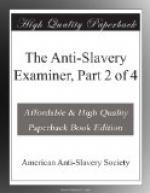on the payment of wages. How does all this
contrast with the predictions of the “practical
men?” “Oh,” said they, in 1833, “it
is idle talking; the cart-whip must be used—without
that stimulant no negro will work—the
nature of the negro is idle and indolent, and without
the thought of the cartwhip is before his eyes
he falls asleep—put the cartwhip aside
and no labor will be done.” Has this proved
the case? No, my lords, it has not; and while
every abundance of voluntary labor has been found,
in no one instance has the stimulus of the cartwhip
been found wanting. The apprentices work well
without the whip, and wages have been found quite
as good a stimulus as the scourge even to negro
industry. “Oh, but” it is said, “this
may do in cotton planting and cotton picking,
and indigo making; but the cane will cease to
grow, the operation of hoeing will be known no more,
boiling will cease to be practised, and sugar-making
will terminate entirely.” Many, I know,
were appalled by these reasonings, and the hopes
of many were dissipated by these confident predictions
of these so-deemed experienced men. But how stands
the case now? My lords, let these experienced
men, come forth with their experience. I
will plant mine against it, and you will find he will
talk no more of his experience when I tell him—tell
him, too, without fear of contradiction—that
during the year which followed the first of August,
1834, twice as much sugar per hour, and of a better
quality as compared with the preceding years, was stored
throughout the sugar districts; and that one man,
a large planter, has expressly avowed, that with
twenty freemen he could do more work than with
a hundred slaves or fifty indentured apprentices. (Hear,
hear.) But Antigua!—what has happened
there? There has not been even the system
of indentured apprentices. In Antigua and the
Bermudas, as would have been the case at Montserrat
if the upper house had not thrown out the bill
which was prepared by the planters themselves,
there had been no preparatory step. In Antigua
and the Bermudas, since the first of August, 1834,
not a slave or indentured apprentice was to be
found. Well, had idleness reigned there—had
indolence supplanted work—had there
been any deficiency of crop? No. On
the contrary, there had been an increase, and not a
diminution of crop. (Hear.) But, then, it was said
that quiet could not be expected after slavery
in its most complete and abject form had so long
reigned paramount, and that any sudden emancipation
must endanger the peace of the islands. The
experience of the first of August at once scattered
to the winds that most fallacious prophecy. Then
it was said, only wait till Christmas, for that is
a period when, by all who have any practical knowledge
of the negro character, a rebellion on their part
is most to be apprehended. We did wait for
this dreaded Christmas; and what was the result?
I will go for it to Antigua, for it is the strongest
case, there being there no indentured apprentices—no




